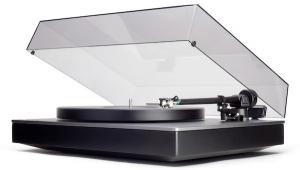geometry dash breeze is an exhilarating addition to the beloved Geometry Dash series, offering players a vibrant and rhythmic platforming experience.
SME Model 30/2 turntable Page 2
The oversized (13", 17.6 lbs) platter rotates on a 6.75"-long, ¾"-diameter spindle bearing made of high-carbon, chrome-tooled steel machined to a 1;um tolerance (better than mil-spec) and enclosed in a sealed oil bath. The bearing runs on individually fitted sintered bronze bearings enclosed in a massive sealed housing rigidly fitted to the suspended subchassis.
The three-phase, eight-pole motor is electronically commutated, free of "cogging effect," and weighs 5 lbs. It's isolated on adjustable urethane mounts, and drives the platter via a crowned stainless-steel pulley machined to ±2.5;um. The pulley is secured to a ground tungsten-steel shaft with twin grub screws to maintain concentricity and rotational balance. When you see a pulley mounted with a single set-screw, think about it: for the shaft to fit into it, the diameter of the pulley's mounting hole needs to be wider than the diameter of the shaft. If you secure the pulley with a single set-screw, it must be offset from the shaft's center—no matter how well it's machined, it's not going to be concentric.
The motor drives an 8.25", 5-lb subplatter via a ground-rubber belt. Three selectable, trimmable speeds—33 1/3, 45, and 78rpm—are available from the outboard power supply. Once a speed has been chosen, the platter reaches speed quietly, smoothly, and quickly. A greater variation in speed is available for 78s, for which there were so many nonstandard speeds.
Other points worth mentioning: As with the far less expensive SME Model 10, which I reviewed in the April 2000 Stereophile, the platter face is made of softer-than-vinyl Isodamp, diamond-turned with a fine scroll that imparts a fiber-like finish said to improve record-platter intimacy. There's a heavy, screw-on, machined reflex clamp. The heavy brass arm-mounting plate fits on tiny alignment pins and is machined to such tight tolerances that two small "jacking screws" are threaded through the plate—you have to screw them down to lift the plate, and even then, it's not easy. This is indicative of the 30/2's machining quality and fit'n'finish, and it's what you should expect in any 'table costing more than $10,000. Should you use a variety of tonearms, your setup will be precisely maintained.
There you have it: a no-BS, industrial-grade turntable using one high-quality motor plus electronic drive, a crowned stainless-steel pulley, a compact, high-mass plinth system, ultra-low-tolerance machining everywhere, zero use of acrylic, and a truly effective isolation system.
I went into the listening part of the review figuring I'd like the sound of the 30/2. As much as the Rockport System III Sirius that I reviewed in August 2000? I sure hoped so, considering the differences in price, size, and complexity. If the 30/2 was almost as good as the Rockport—let alone better—that would be good news indeed.
Hello, Darkness, My Old Friend
Jim Alexander, Sumiko's analog specialist, stopped by to set up the Model 30/2, though it was so simple that even a hi-fi dealer could do it. The supplied SME IV.Vi tonearm ($3000 without cable) was fitted with a Sumiko Celebration cartridge, so that's what I listened to first.
I was surprised by what I heard. In my original review of the Celebration in the February 2001 Stereophile, I described it as "an extremely well-balanced, rich-sounding, reasonably detailed transducer. Its pronounced but not excessive bass response helped create big but well-controlled sonic pictures, the midrange was on the warm yet slightly dry side, and the top was extended but certainly not up there with faster, airier, ultra-detailed...cartridges." I continued: "the Celebration, like the EMT TU-3 Geyger I reviewed [in February 2000], sounded rich and vivid, with a slight but cannily drawn bass bump, a golden midrange glow, and a crisp, grain-free, but not hyper-extended top end."
Mounted on the combo of SME IV.Vi plus 30/2, the Celebration sounded far more neutral, with outstanding bass control and rhythmic certainty. I heard no "bass bump" or "pronounced...bass response" or "golden midrange glow." While I'd enjoyed the Celebration before, it now sounded much better, more neutral. Of course, the Celebration was "voiced" on the SME 30/2 with SME IV.Vi arm!
- Log in or register to post comments





















































